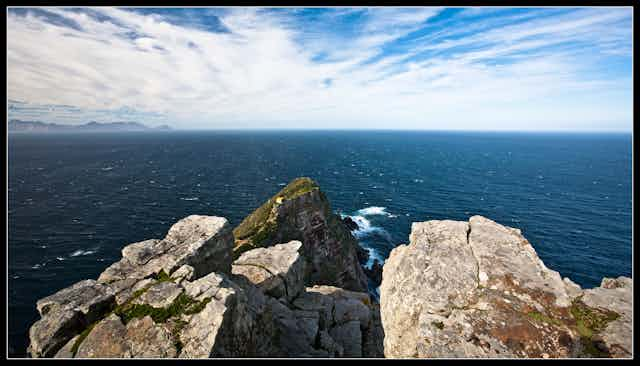South Africa has one of the fastest and strongest flowing currents in the world running along its east coast: the Agulhas Current. It influences local as well as global rainfall and climate. Katherine Hutchinson explains why it’s important to monitor a current that plays a significant role in the global ocean conveyor belt.
What is the impact of the Agulhas Current on the local climate and why does it matter in the global context?
The Agulhas Current transports warm tropical Indian Ocean water southwards along the South African coast. It modulates the rainfall along the east coast and interior regions of South Africa by providing the latent heat of evaporation needed for onshore wind systems to pick up moisture and carry it inland.
The current itself also sets the backdrop for local ecosystems which contribute to South African fisheries. Friction between the current and the continental shelf edge drives upwelling of nutrient rich bottom water. This in turn promotes high levels of phytoplankton – the grass of the ocean which sustains the aquatic food web.
The Agulhas Current also plays a critical role in global ocean circulation which is why it’s considered important for climatic conditions across the world.
This is due to a process known as the Agulhas Leakage. The current flows along the east coast of South Africa and then turns back on itself flowing into the Indian Ocean. But during this process (known as a retroflection), large pockets of warm, salty, Indian Ocean water are pinched off from the current. They form ring-like structures called Agulhas Rings or eddies which are massive spinning vortices. These eddies slowly head north-westwards, crossing the South Atlantic Ocean and eventually feed into the Gulf Stream which flows along the east coast of North America.
The Gulf Stream helps modulate the climate conditions of North America and Western Europe.

How do we know this?
Oceanographers understand currents by measuring the changes in the ocean. But the challenge up until recently had been that the data collected on the Agulhas System only explained the current’s behaviour at a certain point in time.
As a result, many oceanographers have turned to computer models that simulate how ocean currents respond to other factors – like winds – which are measured by satellites. These models are not perfect, but can be very useful in providing insight into connections between different factors affecting the ocean.
The complex nature of the Agulhas Current has made it very difficult to simulate using ocean models. Until 2010 oceanographers were only able to observe the Agulhas Current with snapshots they got by deploying instruments during research cruises.
But scientific developments, combined with international collaboration, have allowed South Africa to place two long term monitoring lines across areas of the ocean where it’s believed critical exchanges of heat and salt are taking place. Heat and salt are essential parameters as they determine the buoyancy of a water mass, its tendency to sink or float. Buoyancy differences and wind forcing are the two mechanisms that drive ocean circulation.
To measure the oceans response to climatic changes (alterations in heat and salt fluxes and shifts in wind patterns), continuous monitoring is needed. These monitoring lines are made up of instruments placed throughout the water column. They measure current speed, direction and temperature at extremely high temporal resolutions.
The first array ran from 2010 to 2013 (the Agulhas Current Time-series) Experiment). This consisted of moorings placed across the Agulhas Current just off the coast of Port Elizabeth. In 2015 oceanographers replaced it with the Agulhas System Climate Array. These moorings are currently measuring the evolution of the Agulhas Current with time, providing scientists with vital information on the current’s behaviour.
Where are the gaps?
The ASCA array sheds a great deal of light on the behaviour of the Agulhas Current and the local implications for South Africa. But it doesn’t provide information on the amount of warm Agulhas water being leaked into the South Atlantic. This leakage is a critical link in the global ocean conveyor belt and so understanding how it is changing over time is essential in preparing for the consequences of climate change.
Another project was initiated in 2013 to measure the exchange of water from the Indian Ocean into the South Atlantic, the South Atlantic MOC Basin-wide Array (SAMBA). South Africa, in collaboration with France and Brazil, placed a series of instruments to capture the “corridor” of Agulhas Rings that cross the Atlantic. The aim is to monitor long term changes in inter-ocean exchange at the east and west borders of the South Atlantic.

Brazil, the United States and Argentina have deployed similar moorings on the western portion of the basin contributing to the end goal – to create a basin-wide array to bridge the entire South Atlantic.
What do we know so far?
South Africa is located at a major crossroad of ocean-basin exchange between the Indian and Atlantic Oceans. Several modelling studies have tried to simulate how these exchanges will alter with climate change under varying scenarios. But they have often produced conflicting and inconclusive findings.
Oceanographers previously believed that the Agulhas Current had been strengthening over time due to an increase in the Southern Hemisphere winds. But the array showed that it has been broadening and not strengthening. The effects of this broadening are currently being investigated, but one outcome is that a wider current allows for a greater exchange of water between the inshore and offshore areas meaning that pollutants will more easily be shifted out to sea.
It’s crucial that in-situ monitoring of the Agulhas Current system continues. This kind of data will allow scientists to detect changes in the current over time. It will also help oceanographers improve their models and help them understand how variations in the current affect local and global ocean circulation and climate.

